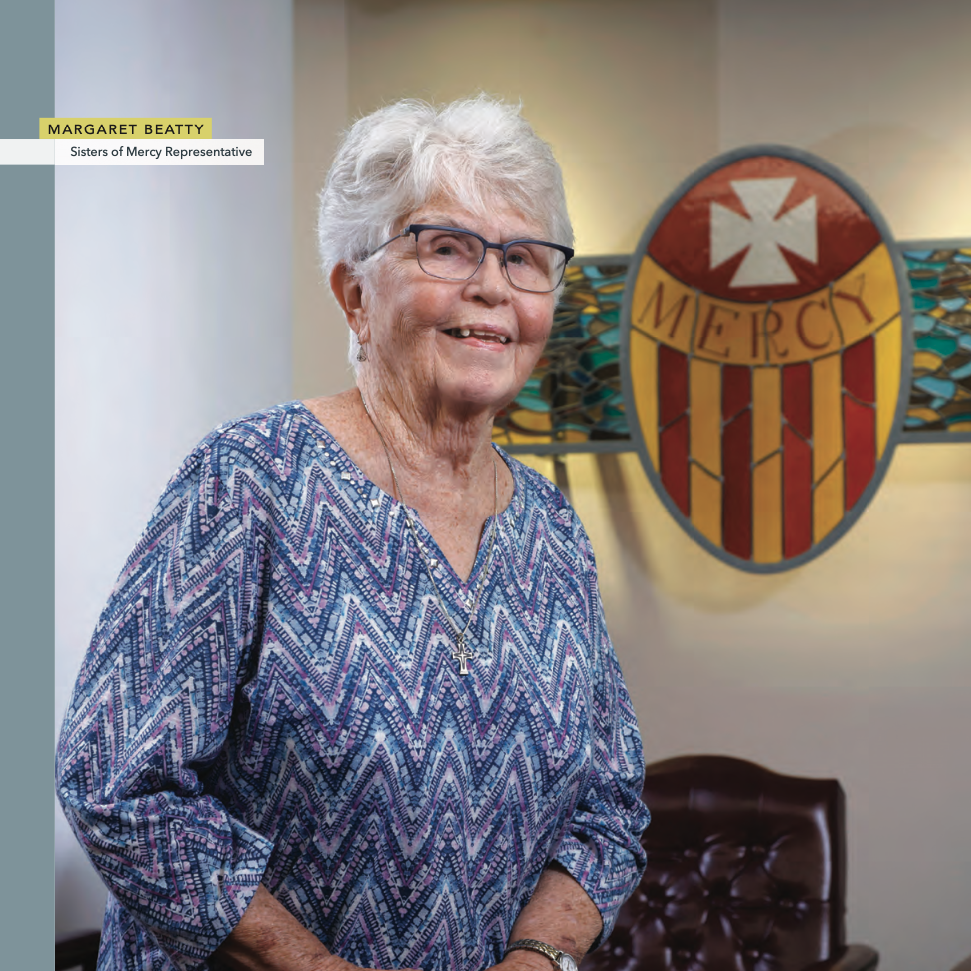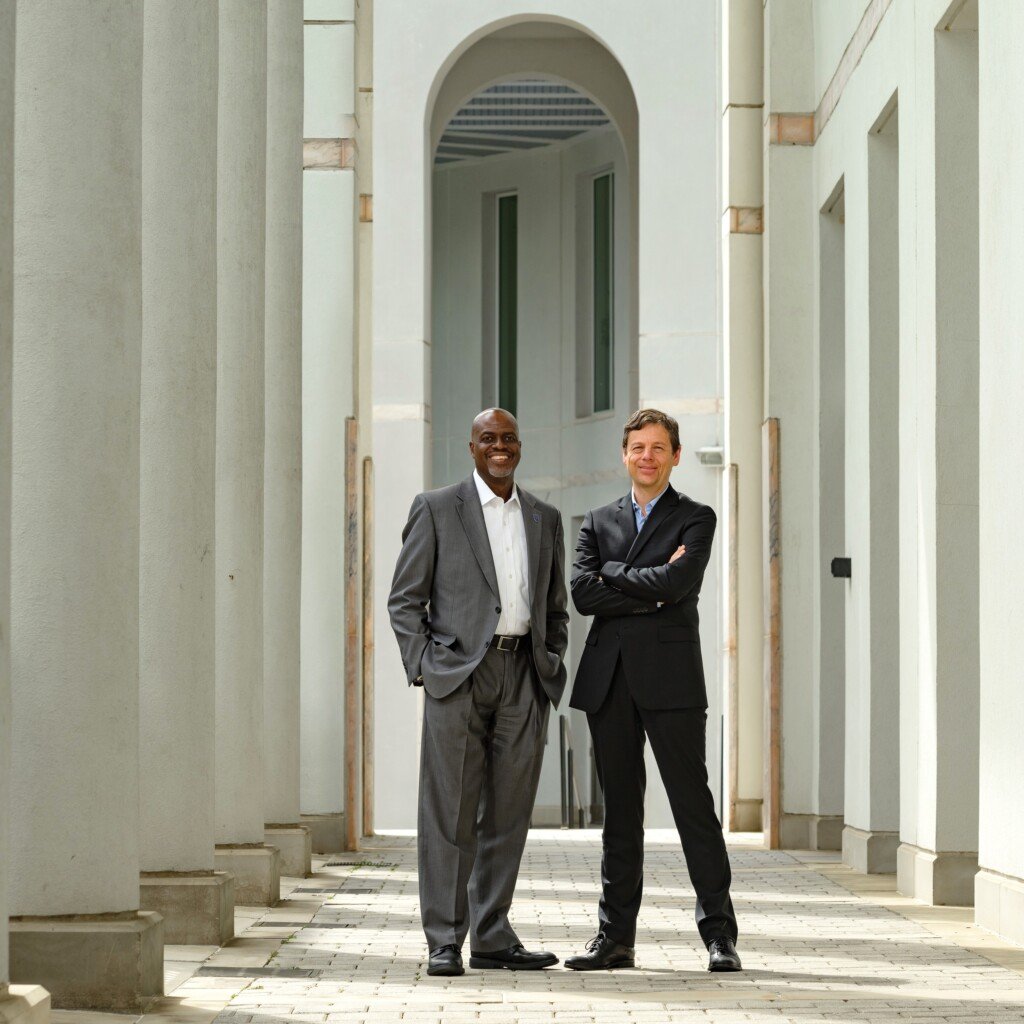South Metro CIDs: Punching Above Their Weight
Using learnings acquired over the past three years, South Metro CIDs look to leverage smart growth opportunities to lead and drive change.
Community improvement districts (CIDs) in Georgia are some of the most powerful and influential public-private partnerships. Using self-imposed tax revenues from commercial businesses within their districts, CIDs have been able to drive positive improvements, from safety to infrastructure and transportation to beautification. A 2021 white paper on Atlanta CIDs indicates that on average, for every dollar spent by CIDs, it leverages $5 in outside funding. The findings were published by Georgia Tech and Lexicon Strategies in the paper, Ready for the Smart(er) City: How Community Improvement Districts (CIDs) Are Building the Future.

Resourceful Collaborator: Gerald McDowell, executive director of the ATL Airport CIDs; photo Brandon Clifton.
The economic challenges triggered by the pandemic underscored the importance of the five South Metro CIDs as essential, cost-effective tools for transforming Downtown Atlanta and the southern crescent’s economy. Many of the area’s largest public infrastructure projects, beautification efforts and security initiatives are now being driven by South Metro CIDs, whose public-private partnerships have proven to be remarkably open to using “smart” concepts, technology and innovation as tools to facilitate projects and programs, which, in turn, benefit community, infrastructure and economic development.
“Collaboration and cooperation are how we foster economic development and encourage new investment in South Metro,” says Michael Hightower, CEO of The Collaborative Firm (TCF), one of the largest minority-owned planning firms in the Southeast. In March, Hightower’s firm hosted its 21st South Metro Development Outlook (SMDO) Conference. Its theme, “Transforming for the Future,” focused on how the interconnected relationships between the commercial, political and public service arenas drive economic growth and targeted development in South Metro Atlanta. “By bringing together CIDs, key educators and large employers who are stakeholders in the area’s success, we’re looking at how our region can support the industries in South Metro – workforce, efficient transportation, education – so investors and developers see the value of this progressive region and want to be a part of an area whose population saw double-digit growth in the past 11 years and is the home of Hartsfield-Jackson Airport, the crown jewel of the south side,” says Hightower.
Thanks to years, and in some cases decades, of consistent, visionary leadership, the South Metro CIDs are leveraging their momentum to transform concepts into reality.
21st-century Infrastructure
Gerald McDowell, executive director of the ATL Airport Community Improvement Districts (AACIDs), is clear-eyed about the challenges that come with overseeing a whopping 15.5 square miles of some of the most visible and widely used stretches of land on Atlanta’s south side. Drawing on decades of experience in technology, then stints in several Gwinnett County-based CIDs, McDowell arrived at the AACIDs in 2015 with the confidence that technology was going to be part of his tool chest. Since then, he’s carved out a reputation as an enormously resourceful collaborator, willing to embrace everything from smart technology as a means to improve transportation and safety to creating a litter control program to maintain the integrity of the area.

Grounded in Technology: A high-tech camera system lets the Atlanta Airport CIDs monitor their members’ properties to supplement regular everyday patrols, enhancing safety; photo contributed.
The ATL Airport Community Improvement Districts is the umbrella organization under which the Airport West Community Improvement District (AWCID) and the Airport South Community Improvement District (ASCID) operate. Between the two, they oversee parts of Atlanta, College Park, East Point, Hapeville and South Fulton, plus Fulton and Clayton counties. Within these districts are Delta Air Lines headquarters, Wells Fargo corporate offices, Porsche Cars North America headquarters, and enormous freight and warehousing operations.
Working with a $3 million budget, the AACIDs have received more than $100 million in grants and project funding under McDowell’s leadership. His team works from a master plan created in 2016 by Kimley Horn, a planning and design consultancy. And while the bones of the master plan haven’t changed (beautification, safety and transportation), McDowell has taken that plan from boots-on-the-ground to an operation grounded in technology.

Livable Downtown: A.J. Robinson, president of both Central Atlanta Progress (CAP) and Atlanta Downtown Improvement District (ADID; photo woodiewilliamsphoto.com
Now in the third phase of the safety plan, the AACIDs are using technology to supplement security that patrols 24/7/365. Currently, there are 86 license plate readers (LPRs) spread throughout the area. In 2022, the AACIDs implemented the FUSUS integrated surveillance camera system, which allows the CIDs to monitor member properties that allow access to their system.
McDowell is bullish about using emerging technology to improve the flow, efficiency and safety of freight and transportation around the airport. “We must make sure appropriate infrastructure is in place to support the activities of the airport and future growth,” he says.
Plans are well underway to identify funding and sites to build a personal rapid transit pilot (PRT) program. PRTs are three- to four-person driverless podcars programmed to make stops at specific locations. The system could be operational by 2025. The AACIDs are also looking to launch an autonomous shuttle pilot and an on-demand transit system.
“Beautification, safety and transportation: Our objective is to ensure that the appropriate infrastructure is in place to support the activities of the airport area and future growth of the airport area,” says McDowell.
Creating a Place to Call Home
“The trend toward making downtown more livable – from multifamily housing to students and to those who want to live, work and play – is really where we’re focused,” says A.J. Robinson, president of both Central Atlanta Progress (CAP) and Atlanta Downtown Improvement District (ADID). “Probably the best example of that is The Stitch. It’s a big, ambitious project that will take somewhere between six and 10 years to build.”
This transformative “highway cap” project will reconnect Midtown and Downtown Atlanta, creating approximately 14 acres of urban greenspace and transportation improvements atop a new, ¾-mile platform spanning the Downtown Connector between Ted Turner Drive and Piedmont Avenue. It will be a catalyst for revitalizing north Downtown with 3,000 to 3,400 affordable housing units, low-cost transportation and jobs. Billions of dollars in value creation are projected along with over $50 million in new revenue.
The City of Atlanta and the Atlanta Downtown Improvement District have already secured over $4 million in funding to support initial planning and concept design for The Stitch. The next step is completing the preliminary project engineering – a scope of work totaling $21 million. The City of Atlanta has provided $10 million in engineering funding. In March 2023, the U.S. Department of Transportation awarded The Stitch a $1.1 million Reconnecting Communities Pilot Program grant.
For the short term, Robinson says they’re getting ready to embark on a study that will look at converting older office buildings into residential dwellings. Recently, the City of Atlanta purchased the property at 2 Peachtree Street with the intent to convert it into a mixed-income, mixed-use site. “There are other properties in our Downtown district that could be appropriate. We’re finding the best Mixed-use Site: 2 Peachtree Street, Downtownstrategy,” says Robinson. “We think it will be a strategy that will inspire other cities to do the same.
“A number of infrastructure projects slowed or got stuck during the COVID years. We’re lining up with the city to get them back on track and jumpstart projects that will make Downtown more functional and livable,” says Robinson. Some of them include better trash and litter removal and pedestrian crossings. “And we’ve got a whole new initiative to figure out so we can be a cleaner community for walkers and drivers,” says Robinson. “We’re constantly working on public safety, an issue people always want to talk about, and how to better address homelessness, including stepping up our own outreach services.”
After more than 20 years at the helm of CAP and ADID, Robinson’s to-do list is endless. “We face a number of positive deadlines in the coming years. One is the World Cup, which is coming in 2026,” says Robinson. “It’s been described to me as something like six Super Bowls, all within a period of a couple of weeks. Downtown really is Atlanta’s postcard, and our community will continue to shine long into the future.”
 Maintaining Momentum
Maintaining Momentum
“The transformation of the district over the past decade has been tremendous. Atlanta’s not getting smaller; it’s getting bigger,” says Gil Prado, executive director of the Boulevard CID. “We have to be able to accommodate that fact to make the Fulton Industrial Community Improvement District ripe for more growth and investment.”
Having been with the Boulevard CID since it started, Prado has been a driving force in revitalizing the long-overlooked Fulton Industrial Boulevard District, which came into sharp focus during the pandemic due to the huge role it played in producing food and beverage for much of the Southeast (Frito Lay, Quaker Oats, Publix bakeries, Pepsi and Coca-Cola are just some of the large manufacturing facilities here) as well as ensuring truckers could keep things moving. It’s the largest industrial district in the Eastern U.S. with more than 52 million square feet of industrial space, more than 500 industrial buildings, 28,000 jobs and a $2.4 billion payroll. Its location near I-20, I-285, Hartsfield-Jackson International Airport, Downtown Atlanta and intermodal rail facilities make it a key player in Atlanta’s burgeoning role as a logistics and transportation juggernaut.
So, in addition to continuing his focus on the basics – public safety, litter-free streets, cleaned-up landscaping and road improvement projects – Prado has secured a number of big wins over the past year, both for short- and long-term projects.
 Topping the list was the Freight Cluster Plan, which was funded by a $250,000 grant from the Atlanta Regional Commission (ARC) and another $50,000 by the CID. The 52-point plan calls for $30 million in transportation infrastructure improvements over the next 10 years. It has already been awarded $3.5 million, of which the CID committed $890,000 to improve the intersection at Donald Lee Hollowell Parkway and Fulton Industrial Boulevard, which is considered a critical entry point for trucks and vehicles to access the entire district.
Topping the list was the Freight Cluster Plan, which was funded by a $250,000 grant from the Atlanta Regional Commission (ARC) and another $50,000 by the CID. The 52-point plan calls for $30 million in transportation infrastructure improvements over the next 10 years. It has already been awarded $3.5 million, of which the CID committed $890,000 to improve the intersection at Donald Lee Hollowell Parkway and Fulton Industrial Boulevard, which is considered a critical entry point for trucks and vehicles to access the entire district.
Also on the books is a $5 million improvement at the intersection of Cascade Road and Fulton Industrial Boulevard, which should begin in 2024. Then there’s the forward-looking exploration of developing an electric vehicle and freight infrastructure master plan to address everything from EV charging stations, an electric grid strategy, clean fuel for medium- and heavy-duty trucks and clean energy best practices.

Tremendous Transformation: Gil Prado, executive director of the Boulevard CID, by the Stella Nova sculpture; photo Brandon Clifton.
“Public safety is an ongoing investment. We’re using crime-fighting technology, such as security cameras and license plate readers [LPRs] throughout the district,” says Prado. “By the end of 2023, we’ll have 60 LPRs in and around the district, sponsored by Flock Safety, the city of South Fulton and the Fulton Country Police Department. We’re also funding approximately 4,600 police patrol hours.”
Prado says the Fulton Industrial district has a long history of public art. In 1969, 30 public sculptures lined Great Southwest Parkway and, in 2019, the CID purchased and installed Stella Nova, a 16-foot-tall sculpture at the I-20 Interchange. “Now we are in the process of pursuing a creative placemaking plan to create a blueprint to guide future art placement in the district,” says Prado.
Trust for Public Land has completed its purchase of an 8.2-acre site along the Chattahoochee River, part of which falls in the Boulevard CID. Prado and his team will be working closely with their partners in this initiative, which will create a regional trailhead park.
Location, Location, Location
“The South Fulton area is the logistics hub of the region. Proximity to the airport, access to I-85 and available land, warehouses and industrial sites is what attracts most business to the South Fulton area,” says South Fulton CID administrator Joddie Gray. “But what makes the area truly unique is the committed group of commercial property owners dedicated to improving the area.”

Infrastructure Improvements: Rendering of the Donald Lee Hollowell Parkway/Fulton Industrial Boulevard intersection improvement project; photo contributed.
Located primarily along the I-85 and Oakley Industrial Boulevard corridors, the area experienced substantial growth in warehousing and distribution centers as a result of the Fairburn CSX Intermodal Center, a high-volume rail corridor. For more than 20 years, the South Fulton CID’s property owners, some of which include U.S. Foods, Red Rock Development, CSX Transportation, DHL, Prologis and more, have led a multi-prong strategy to spur investments in logistics to keep pace with Atlanta’s exploding growth as a logistics center. As the logistics industry continues to innovate, there will be even more demand for better connections. “We work closely with the Boulevard CID and AACIDs to coordinate and complement each other because we’re all about what happens for one happens for all,” says Gray.
When the world shut down during the pandemic, many of the manufacturers in South Fulton such as Clorox, U.S. Foods and Duracell kept much the region running by supplying critical inventory to frontline workers. “We had to get workers to work and vehicles to where they needed to go,” says Gray. And while the pandemic may be in the rearview mirror for much of the world, Gray says the need for workers and infrastructure hasn’t slowed down. “We’re not just looking [toward] adding capacity; we’re looking at every way to make our roadways more efficient and encouraging alternative modes of transit,” she says.

Logistics Hub: Joddie Gray, South Fulton CID administrator, at a U.S. Foods distribution center in Fairburn; photo contributed.
Reconstruction of the interchange at SR 74 and I-85 was slated to begin in 2022, but details are still being ironed out. This ambitious project would help relieve bottlenecks in what is considered the most congested intersection in the CID by increasing capacity and diverting nonfreight traffic away from freight corridors.
Over the short term, work was completed on a 200-space park-and-ride in Fairburn that was built to relieve congestion in advance of the I-85 and SR 74 interchange reconstruction. Numerous other projects are in various stages of planning, including the Howell Avenue roadway extension, adding sidewalks to Bohannon Road – running from McLarin Road to Oakley Industrial Boulevard, and a freight intelligence system to relieve congestion and improve mobility around Fairburn’s CSX intermodal terminal.
“There’s so much to be done. We’re very excited to about the future. I wish every project could be expedited,” says Gray.
Partnering for Big Impacts
“We’ve always been very pro-partnership and cooperation,” says Nicole Hall, administrator for the West End CID. “In
fact, the landscaping you see at the I-20 interchange at Lee and Lowry streets – what’s considered the gateway to the West End – is the result of our partnership with the City of Atlanta and the Georgia Department of Transportation (GDOT).”

Efficient Planning: Nicole Hall, administrator for the West End CID at the RICE Center; photo Brandon Clifton.
West End is one of Atlanta’s oldest and most historic neighborhoods, and the CID encompasses some of that history within its boundaries – commercial and industrial property south of I-20, including properties along Lee Street, Ralph David Abernathy Boulevard, White Street and Donnelly Street, and the Atlanta University Center. Hall cites three major initiatives she and her team are working on: A public safety program featuring license plate readers and a police officer in a marked unit who does community policing; landscaping and beautification; and the Ralph David Abernathy Great Streets Study, funded by a $160,000 grant from the Atlanta Regional Commission (ARC) and $40,000 from the West End CID as part of its Livable Centers Initiative. “It’s an efficient intermodal transportation plan for the Ralph David Abernathy corridor that will connect the West End MARTA Station, West End Mall and the surrounding neighborhoods,” says Hall.
Project manager Chris Pierre says the CID has been bolstered by several developers who have made significant investments in the area, including Ackerman & Co. and MDH Partners’ Lee + White, a 426,000-square-foot cluster of warehouses along the BeltLine that were redeveloped into a mixed-use project. Just down the road, Ackerman & Co. and MDH Partners are moving forward with the next phase of Lee + White that includes a food hall, retail and loft offices.
“New partners and new board members mean greater revenue for our organization so we can do more. It’s an exciting time for our organization and our community,” says Hall.









